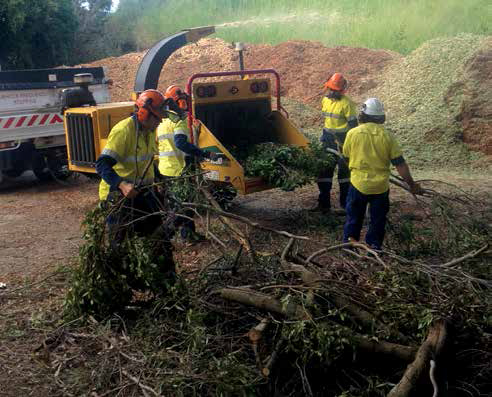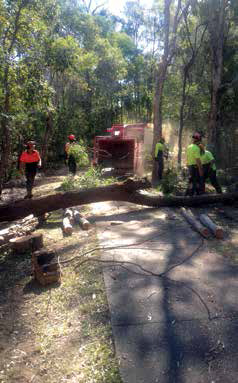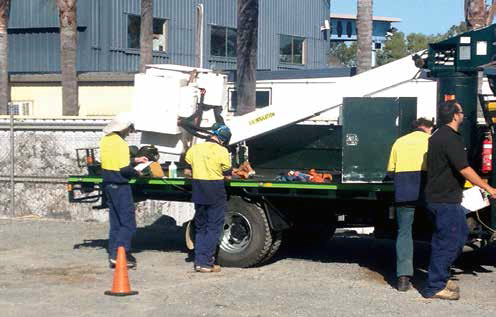The Arboricultural industry has worked with AgriFood SKILLS Council Australia and achieved a defined pathway for ongoing learning & development.
From chipper operations to clean-ups, we no longer lack in training package options.
Hi everyone, as I am writing this article the Christmas promotion has been going for the past three months. The decorations and lights are getting dusted down and it looks like summer time is getting revved up for a really hot one.
At Training For Trees we have been kept busy with all sorts of exciting developments and have to say we are looking forward to a relaxing end of year break.
The big news is that as we move forward into a new year and all things good standards in arboricultural training packages following extensive consultation and consideration as to the general expectations of industry are going to be reaching new levels.
As the Director / principle trainer assessor within Training For Trees and also as education adviser and member of the Queensland arboricultural association executive committee my colleague Bill Wilcock and I along with our fellow committee members support have been part of a technical reference group tasked with advising our industry skills council (AgriFood Skills Council Australia) regarding the arboricultural industry skills requirements and the standards required to become a qualified arborist.
We attended meetings, industry consultation and teleconferences as well as undertaking many hours of phone calls and emails, mostly outside of normal business hours. We listened to feedback from interested persons along with sometimes heated debates and fought tooth and nail towards the greater good which overall is to the benefit of training and education within the Australian arboricultural industry.
We were privileged to be working alongside highly qualified, passionate industry individuals who collectively donated countless hours and effort on a voluntary, unpaid basis to advise and assist with this process.
A consultant employed by AgriFoods then collated all the recommendations and ensured that they fitted into the strict rules of the Australian Qualifications Framework (AQF) – thank you, TRG members.
Full details regarding the new training packages will be published on AgriFood Skills Australia website in the near future.
In a nutshell we now have the following options for the arboricultural industry with a defined pathway for ongoing learning and development.
Certificate II in ArboricultureIt includes major changes and will now cater for the groundies, covering general tree work operational requirements. It also includes units of competency such as chainsaw tree felling chipper and stump grinder. |
Certificate III in ArboricultureMajor changes include the option to choose a particular specialisation (Stream) relative to the individual’s choice of direction within the industry. There will be three options to choose from to become qualified at trade level (Certificate III).
|
Certificate IV in ArboricultureThis level of qualification has been developed to meet the needs of the supervising arborist. |
Diploma in ArboricultureThis is the level to begin your consultancy career with supervisory and report writing skills required. |
Advanced Diploma in ArboricultureThis level is where the tree diagnostics biology and biomechanics play a big part. |
Graduate Diploma in ArboricultureThis level culminates in a Bachelor of Arboriculture, a university level qualification, and requires infinite knowledge of all things Arboriculture. These developments are extremely important to the future of arboriculture in Australia. We have never been able to achieve such a positive outcome and direction for our industry. It certainly puts us on the map alongside the rest of the world regarding arboriculture embracing new technology and systems. |
Chippers and Clean-up OptionsFor this issue of AA I would like to cover some relevant points in regard to chippers and clean-up options. |
 Unfortunately we are still hearing of accidents involving chippers with severe consequences. It seems all too common that entanglement with ropes getting fed into the machine or problems with winching cited the major cause.
Unfortunately we are still hearing of accidents involving chippers with severe consequences. It seems all too common that entanglement with ropes getting fed into the machine or problems with winching cited the major cause.
If a rope inadvertently gets fed into the machine while it is operating, usually it will wind in around the cutting mechanism extremely quickly. If the rope is attached to a portawrap it will pull tight. We have seen reports of injuries that have included limbs almost severed by the force of the rope cutting into them. If the rope is attached to the climber then the outcome would be even worse!
The other incident we hear of involves winching timber into the feed hopper resulting in crush type injuries caused to the operator who has usually attempted to assist the direction of timber feeding into the machine and got trapped against the feed table.
Recently we heard of an incident related to the use of pulleys to divert the pull. A wrong sized, non-compatible pulley was used to redirect a section of tree that was getting winched towards the chipper. It all resulted in a system failure where the non-compatible pulley caused the winch rope to be cut and fail.
None of the above mentionedincidents were caused by faults within the machines. Machines have to pass stringent safety requirements and carry extensive guarding and warning decals. These incidents are generally caused by a lack of planning and preparation on the worksite.
I have included a few points for consideration but the list is not intended to be used as a substitute for training and assessment.
- Only allow trained operators to use the machine.
- Ensure the operator manual is affixed to the machine and all operators are familiar with it.
- Set up on site with appropriate signage to enable appropriate exclusion zone to be established.
- Undertake a risk assessment and comply with SWMS.
- Keep all ropes at safe distance from the machine (in rope bags).
- Operate at correct engine speed.
- Position discharge chute correctly and check security of all guards.
- Only one operator to feed the machine at a time in sequence.
- Organise feeding so that each operator leaves clear for the next.
- Keep area clear around feed hopper, rake up frequently.
- Don’t stand directly behind the machine, feed from the side.
- Don’t leave machine running unattended.
- Shut machine down when tree work operations are underway to allow communication and reduce chances of feeding in ropes accidently.
- Use a push stick for the shorter off cuts or feed another long branch to carry them in, do not reach into the feed hopper with hands or feet.
- Do not exceed machine capacity.
- If machine becomes blocked, shut down correctly and remove keys, allow to reach a complete standstill lock out and clear.
- When winching ensure operators are trained.
- Use appropriate communication.
- Maintain a safe position to operate the controls.
- Keep hands and feet clear.
- Use approved rigging techniques.
- Use correctly matched hardware such as slings and pulleys, check the WLL of all components.
- Keep all persons clear of the danger zones.
- Prior to leaving the site check that all loose debris is removed from the machine and that the discharge chute is correctly and securely stowed.
Do Chipper Operators Need A Ticket?
WH&S states that persons must be adequately trained. A nationally recognised statement of attainment such as FPIHAR2206B Operate a Mobile Chipper/ Mulcher would ensure approved training assessment has been carried out.
Clean-up Operations
That brings me to the subject of handheld, backpack, electric blowers. The list is endless, with wind speeds enabling the most stubborn leaves and sawdust to be swept up into a pile for loading into the truck.
Has anyone ever read the manual that comes with a new machine? Has anyone been on a course to enable its safe operation?
Consider some of the potential hazards and risks such as:
- Flying debris
- Noise
- Vibration
- Fumes
- Burns and fire risk
- Fuel spillage
- Entanglement if the guards are not secure
- Emissions (Better not go there!)
We need to wear the required PPE such as safety glasses and hearing protection, be aware not to raise dust storms while operating these machines and carefully consider their safe use and operation.
Imagine in the old days we had to use a yard brush and sweep up whole areas. Then, instead of scattering the debris over a wide area, we had to pick it up and load it into the truck.
So consider the environmental implications and the risk to bystanders while operating these machines. Be aware when using them to blow down roads that you don’t inadvertently walk into oncoming traffic. Keep the debris out of the drains and don’t try and share it around all of the neighbouring properties. You will need to shut the machine down at times to gather up the debris and load it onto the truck.
Another thing to consider regarding clean-up operations is safe lifting and handling techniques. The use of mechanical means for lifting or cutting larger items into manageable sections needs to reduce the chances of long term, irreparable back injuries.
Now is the time to evaluate your options regarding qualifications with the new packages coming online in the near future. It will be no problem to upgrade or advance into the new levels. It is an exciting time, we no longer lack in our available training package options and have the ability to match the level of qualification to the requirements of industry.
Career Pathways
At TFT we constantly remind our students of the bigger picture of arboriculture and the pathways that can be taken for a lifelong career and this often raises questions like “How do I become a consultant, manager or business owner?”
There is no easy answer but it generally means carrying out the hard yards and starting out at the bottom as a groundie, learning how to become part of a team, dragging brushwood and carrying logs to feed the chipper, progressing to learning a few simple knots to be able to tie things on the climber’s line and to develop some tree knowledge along the way. This may not seem too glamorous as most just want to put on a harness and start swinging around in the tree using a chainsaw straight away, which is obviously not acceptable without the correct training.
Our advice regarding this subject is to spend as much time learning the processes and procedures of the job as possible, ask lots of questions and make an effort to learn some tree names. Even when dragging branches to the chipper means you could be learning about trees. How do they smell? How heavy is the wood? Do you get splinters in your hands? What colour is the timber? Are there flowers or fruits? Why is the heartwood soft or hollow? What is in the pruning standard AS4373?
Attend events such as workshops, trade shows and climbing competitions, frequentyour local supplier. Don’t just watch demonstrations on YouTube and pictures online with Google. Go to the shows, walk into the shops, see the gear for real and talk with the experts.
Combine this knowledge some of which can be learned in your own time and on the job with an apprenticeship such as the AHC30810 Certificate III in Arboriculture and begin your career in the wonderfully diverse world of arboriculture.
If you are thinking about undertaking some form of arboricultural qualification pathway, then now is the time to start. Take some ownership over your future career, be excited and look forward to the challenges and substantial rewards.
The current Certificate III in Arboriculture is able to be completed as a climber or with the aerial components completed from an EWP. Considerable funding is available in most cases to assist you in its completion.
Consider your strategy for training and how you can keep your existing qualifications up to date.
 Within the current OH&S legislation there is a general obligation for us all in the workplace with a major emphasis on everyone to act with due diligence. This basically translates to mean the care that a reasonable person must exercise to avoid harm to themselves or others in and around the workplace.
Within the current OH&S legislation there is a general obligation for us all in the workplace with a major emphasis on everyone to act with due diligence. This basically translates to mean the care that a reasonable person must exercise to avoid harm to themselves or others in and around the workplace.
It is a pretty open-ended term placing obligations on everyone while they are at work, including employers, the self-employed and employees with the general requirement to carry out their duties as responsible operators. It is also a requirement for everyone to have received training for their roles and to be deemed competent and current in their required skills.
One way to demonstrate compliance with these requirements is to attend regular refresher training and update courses which are designed to maintain essential skill levels.
Regular refresher and update training and assessment programs to suit relevant skills as required are offered by us at Training For Trees.
Once a unit of competency or a full qualification has been attained, attending refresher and update days is a good way to ensure that the qualifications are kept up to date with the latest requirements. This is an effective way to ensure that any bad habits that may have crept in can be identified and rectified with further training recommended and carried out if required.
Operator training and certification is available through Training For Trees. Persons that are trained and certificated generally have a greater understanding of operations and the required outcomes. The end result is usually seen in less downtime and maintenance requirements and ultimately in the reduction of accidents and injuries.
“Everyone engaged in carrying out work with trees must be trained and qualified in their designated task and strive to maintain and improve their industry currency by continuing to gain relevant experience and qualifications”.
Training is as important as the servicing of vehicles and machinery, after all, workers are the machinery that you run and need to maintain to enable smooth operation of your business.
It has been proven that independent training and assessment increases staff retention safety awareness productivity and efficiency.
Remember to schedule in regular refresher and update training sessions. To be classified as an arborist/ tree worker you will need to undertake AHC20513 Certificate II in Arboriculture which is a good pathway to follow towards becoming a qualified working arborist and undertake the trade level AHC30810 Certificate III in Arboriculture. Funding incentives currently apply to eligible applicants and their employers in QLD.
Merry Christmas from TFT
“Safety rules”Check out your eligibility for funding. Enrol now for Cert II and III Arboriculture. Chainsaw (all levels), EWP Licence, First Aid, Working at Heights, Chipper, Stump Grinder, Polesaw and AC/DC now booking. Contact Training For Trees for your short course RPL or refresher training needs. For details visit the new website www.trainingfortrees.com.au or email info@trainingfortrees.com.au AA |



